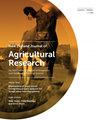Qualitative evaluation of total mixed ration silage containing forage cactus and guinea grass as a nutritional alternative for feedlot-finished sheep
IF 1.5
3区 农林科学
Q2 AGRICULTURE, MULTIDISCIPLINARY
New Zealand Journal of Agricultural Research
Pub Date : 2023-10-25
DOI:10.1080/00288233.2023.2274392
引用次数: 0
Abstract
ABSTRACTThis study aimed to evaluate the fermentation characteristics, microbial populations, losses, aerobic stability and chemical composition of total mixed ration based on forage cactus and different ratios of Guinea grass at four storage times (7, 15, 60 and 100 days). Five diets were formulated with forage cactus as the main ingredient, with varying Guinea grass inclusion ratios: 0, 10, 20, 25 and 30% on a dry matter basis. The experimental design used was a completely randomised design with a factorial arrangement and three replicates. The silages had pH values of approximately 4.0. Lactic acid bacteria were predominant in all silages, and this predominance increased after 7 days of ensiling in all diets, ranging from 8.0–10.1 log10 cfu g−1 of silage. Silages with 10% and 20% guinea grass showed aerobic deterioration, while the others remained stable throughout the aerobic stability test. Guinea grass in combination with forage cactus can be added in total mixed ration silages up to a level of 30%, without compromising the chemical composition, silage losses or fermentative profile. However, considering aerobic stability, the addition of 10% and 20% guinea grass resulted in greater deterioration after 48 h of exposure to air.KEYWORDS: EnsilingMegathyrsus maximusNopalea cochenilliferafermentation profileorganic acids AcknowledgementsSupport of the Coordination for the Improvement of Higher Education Personnel – CAPES and the National Council of Technology and Scientific Development – CNPq.Disclosure statementNo potential conflict of interest was reported by the author(s).Additional informationFundingThis work was supported by National Council of Technology and Scientific Development – CNPq; Coordination for the Improvement of Higher Education Personnel – CAPES.含牧草仙人掌和豚草的全混合日粮青贮作为育肥羊营养替代品的定性评价
摘要本试验旨在研究以牧草仙人掌和不同比例豚草为原料的混合日粮在7、15、60和100 d的发酵特性、微生物数量、损失、好氧稳定性和化学成分。以饲用仙人掌为主要成分,按干物质基础上豚草添加比分别为0、10、20、25和30%配制5种饲粮。使用的实验设计是一个完全随机设计,阶乘安排和三个重复。青贮的pH值约为4.0。乳酸菌在所有青贮饲料中均处于优势地位,青贮7 d后,乳酸菌的优势地位逐渐增强,青贮饲料中乳酸菌的优势水平为8.0 ~ 10.1 log10 cfu g−1。添加10%和20%豚草的青贮在好氧稳定性试验中表现出好氧劣化,其余青贮在好氧稳定性试验中保持稳定。在不影响化学成分、青贮损失或发酵特性的情况下,几内亚草和牧草仙人掌可在混合饲料青贮总量中添加高达30%的水平。然而,考虑到有氧稳定性,添加10%和20%的豚草在暴露于空气48 h后恶化更大。关键词:青贮大头蛇、大头蛇、青贮大头蛇、青贮大头蛇、青贮大头蛇、青贮大头蛇、青贮大头蛇、青贮大头蛇、青贮大头蛇、青贮大头蛇、青贮大头蛇、青贮大头蛇、青贮大头蛇、青贮大头蛇有机酸披露声明作者未报告潜在的利益冲突。本研究由国家科学技术发展委员会(CNPq)资助;高等教育人才培养协调——CAPES。
本文章由计算机程序翻译,如有差异,请以英文原文为准。
求助全文
约1分钟内获得全文
求助全文
来源期刊
CiteScore
4.90
自引率
16.70%
发文量
31
审稿时长
3 months
期刊介绍:
The New Zealand Journal of Agricultural Research publishes original research papers, review papers, short communications, book reviews, letters, and forum articles. We welcome submissions on all aspects of animal and pastoral science relevant to temperate and subtropical regions. The journal''s subject matter includes soil science, fertilisers, insect pests, plant pathology, weeds, forage crops, management systems, agricultural economics, agronomy, and animal science. The journal also accepts crossover papers on subjects such as land –water interactions.

 求助内容:
求助内容: 应助结果提醒方式:
应助结果提醒方式:


